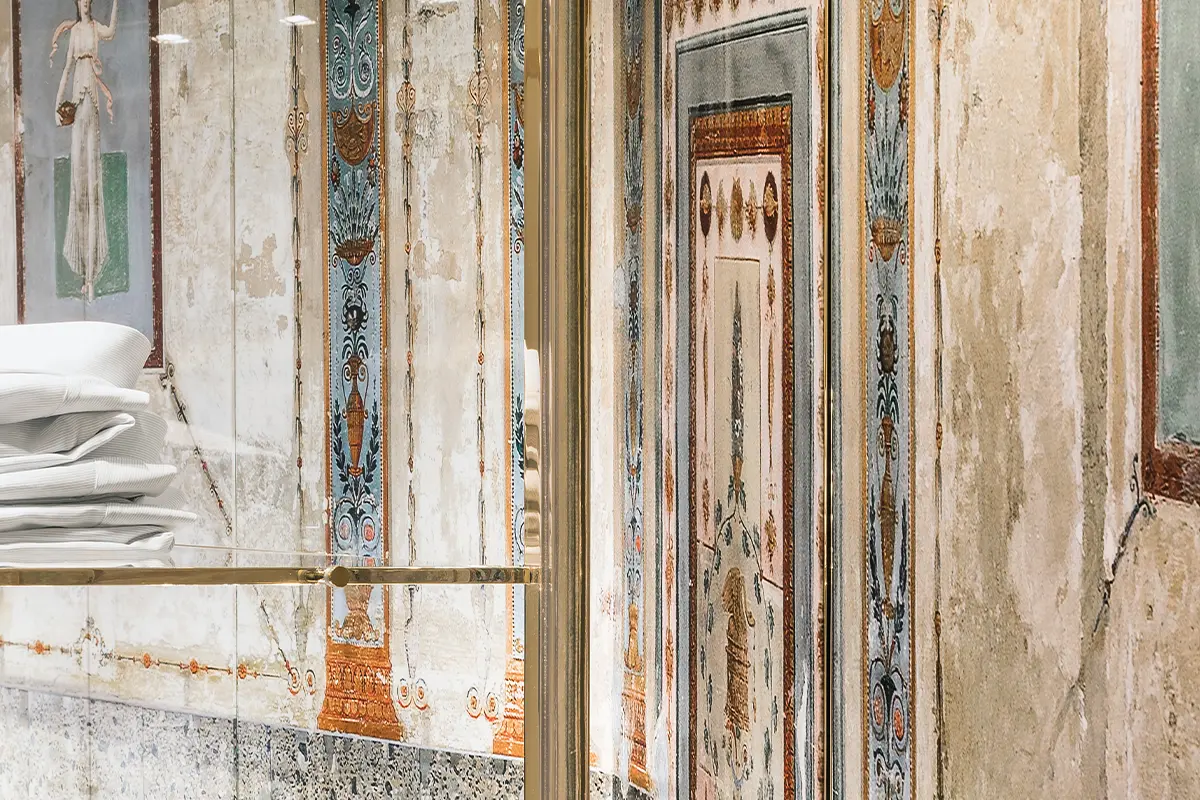A genius loci collection of art and design, a praise to the Florentine taste. Louis Vuitton Florence boutique
The dialogue with different cultures and the concept of identity
The concept of identity is old hat – now it’s all about coherence. To consolidate their identity, brands needed strong consistent codes all over the world to cultivate coherence we have to work on attitude. A constant attitude to dialogue with different cultures, with focus on traditions and territories. Using more technical sector language: going beyond the concept to be repeated at every latitude and opting for dialogue with the soul of different markets. Opening a direct relationship, fitting into the location and its ideas of heritage and life, culture and imprinting.
Florentine Genius Loci
The one in Florence is the first Louis Vuitton store in Italy to put this logic in place. It was designed and realized by a team of architects in part Italian, working in the fashion brand’s technical office. Focus is on the architecture and interior design, which relates with the genius loci of Tuscany’s main city. The message multiplies and is enriched with paintings, sculptures, pottery, bronzes, glassware, vintage furnishings, lamps, wall lights and lighting engineering. All uniquely Florentine.
The boutique Louis Vuitton in Florence
The building site, hidden behind tall wooden barriers, was on-going for almost two years, arousing the curiosity of locals and tourists alike. The boutique has its entrance and store windows on Via degli Strozzi, with more windows on the piazza of the same name and on Via de’ Sassetti. The building itself is an example of historicist architecture from the mid-nineteenth century, with echoes of styles and contributions from the early Renaissance and Mannerism. Florence’s golden age, the era spanning the fall of the Republic and the rise of the Medici, through to the institution of the Grand Duchy of Tuscany in the mid-sixteenth century.
A palazzo built as part of the transformation of the city and its buildings headed by local engineer and architect, Giuseppe Poggi. The five-year period in question, 1865-1870 changed the face of Florence the capital, with demolition of the medieval walls to create large concentric avenues around the city inspired by the Champs-Elysées.
Navona Travertine, Rosso Levanto and Giallo Siena
The store is on the ground and mezzanine floors of the building, its vaulted-ceilinged rooms linked by a central staircase with clear banisters. The handrail is blue, alluding to the objects in lapis lazuli in the Medici cabinets of curiosities.
Light enters the symmetrical interiors through the round arched windows, illuminating the pale flooring in Navona Travertine, reflecting off the surfaces in Rosso Levanto and Giallo Siena, types of marble often used during the Renaissance and Baroque periods, and on the shelves in Breccia Medicea marble, working in synergy with the geometric precision of the store’s artificial lighting.
The silvery grey of the Pietra Serena is totally Tuscan and teams with a pale palette that ranges from beige to variations on a theme of white. Al tones suggested and inspired by the natural play of light and shade on the store interiors.
Florence in the Thirties. Giovanni Michelucci and the Novecento
The artistic and architectonic ‘Novecento’ movement in Florence in the early twentieth century saw recuperation of classicism with hints of modernism. In this mix, inspirational icons included the Santa Maria Novella railway station, a rationalist building from the early Thirties, designed by Gruppo Toscano, headed by Giovanni Michelucci. A masterpiece that teams beauty and functionality, combines various colours of marble with grids, lanterns, locks, handles and metallic elements that look to Bauhaus achievements. Studies investigated Tuscan aromas, the bitter scent of cypress and laurel, the fragrance of the iris, Florence’s fleur-de-lis.
The anti naturalistic shades of Mannerist painting provided yet more inspiration. Collecting plays a leading role. Design pieces have been sourced for the boutique, together with furnishings and artistic artefacts thanks to analysis involving antique galleries and collectors, markets, private collections and second-hand dealers, as well as the collections in the brand’s Paris archives and the specific Objets Nomades and Petites Nomades collections.
The furnishings are mainly vintage, dating back to the Fifties or early Sixties and many bear names crucial for the history of Italian design. Franco Albini, Cesare Lacca, his round table in glass and black-lacquered wood, Osvaldo Borsani, Romeo Rega and Ico Parisi. Armchairs by Lenzi Pistoia and chairs by Nino Zoncada for Cassina, upholstered in beige and dark grey. Everywhere are objects, lamps, wall lights, relief work and accessories in ceramic, Murano glass, bronze and steel, contemporary creations by Studio Superego and Patricia Urquiola, and the bookcase by Renato Polidori in white Carrara marble from 1970, a piece of micro-architecture with a sculpted concept more than a storage unit.
Paintings from the Forties and Sixties
Massimo Listri, Florentine artist and photographer, has covered the walls of one of the ground floor rooms reserved for regular customers with a film that brings alive a photo of the neoclassic hall in Palazzo Reale in Naples, a living trompe-l’oeil effect that throws open and adds drama to the perspective. Another work by Listri takes up a wall in the men’s department on the first floor.
There are also plenty of paintings from the Forties and Sixties and today, by artists such as Marius D. Keppler and Osvaldo Medici del Vascello from Turin but who lived in Florence until he died in 1978. In 1960, Medici painted the oil on canvas entitled Com- posizione Ritmo Astratto, still in its original metallic-effect, polished gold-leaf frame.
Cesare Cunaccia























